Open Journal of Discrete Mathematics
Vol.1 No.2(2011), Article ID:5766,8 pages DOI:10.4236/ojdm.2011.12005
Generalized Exponential Euler Polynomials and Exponential Splines
Department of Mathematics and Computer Science, Illinois Wesleyan University, Bloomington, USA
E-mail: the@iwu.edu
Received April 7, 2011; revised May 4, 2011; accepted May 20, 2011
Keywords: Eulerian polynomial, Eulerian Number, Eulerian Fraction, exponential Euler polynomial, Euler-Frobenius polynomial, B-spline, exponential spline
Abstract
Here presented is constructive generalization of exponential Euler polynomial and exponential splines based on the interrelationship between the set of concepts of Eulerian polynomials, Eulerian numbers, and Eulerian fractions and the set of concepts related to spline functions. The applications of generalized exponential Euler polynomials in series transformations and expansions are also given.
1. Introduction
Eulerian polynomial is defined by the following equation (cf. for examples, [1-3]):
 (1.1)
(1.1)
It is well-known that the Eulerian polynomial,  , of degree
, of degree  can be written in the form
can be written in the form
 (1.2)
(1.2)
where  are called the Eulerian numbers that can be calculated by using
are called the Eulerian numbers that can be calculated by using
 (1.3)
(1.3)
The Eulerian number  gives the number of permutations of
gives the number of permutations of  with
with  permutation ascents (cf. [4]), or equivalently, the number of permutation runs of length
permutation ascents (cf. [4]), or equivalently, the number of permutation runs of length  (cf. [3]), where a set of ascending sequences in a permutation is called a run and
(cf. [3]), where a set of ascending sequences in a permutation is called a run and  is a permutation ascent if the
is a permutation ascent if the  th term in the permutation less than the
th term in the permutation less than the  st term. A geometric interpretation of Eulerian number
st term. A geometric interpretation of Eulerian number  were presented in [5] and [6], where which was found equaling to the volume of
were presented in [5] and [6], where which was found equaling to the volume of  th slice of a
th slice of a  -dimensional unit cubenamely,
-dimensional unit cubenamely, . It is wellknown that the Eulerian fraction is a powerful tool in the study of the Eulerian numbers, Eulerian polynomial, Euler function and its generalization, Jordan function ( cf. [7]). The classical Eulerian fraction,
. It is wellknown that the Eulerian fraction is a powerful tool in the study of the Eulerian numbers, Eulerian polynomial, Euler function and its generalization, Jordan function ( cf. [7]). The classical Eulerian fraction,  , can be expressed in the form
, can be expressed in the form
 (1.4)
(1.4)
 spline functions are probably the most applicable one-dimensional polynomial spline functions. The values of
spline functions are probably the most applicable one-dimensional polynomial spline functions. The values of  spline functions can be defined as the volumes of slices of a
spline functions can be defined as the volumes of slices of a  -dimensional cube (cf. [8]). Hence, one can expect a tight connection between the Eulerian numbers and the
-dimensional cube (cf. [8]). Hence, one can expect a tight connection between the Eulerian numbers and the  spline function values. This is is one of the motivations to study the interrelationship between Eulerian polynomials and B-splines. Another motivation is from the construction of the exponential splines by using the exponential Euler polynomial discussed in [9], which will be described in this paper.
spline function values. This is is one of the motivations to study the interrelationship between Eulerian polynomials and B-splines. Another motivation is from the construction of the exponential splines by using the exponential Euler polynomial discussed in [9], which will be described in this paper.
Polynomial spline functions can be considered as broken polynomials with certain smoothness, which are used to overcome the stiffness of polynomials, for instance the Runge phenomenon. One way to construct the univariate polynomial B-splines is using divided differences to truncated powers, and the truncated powers can be generated by iterated integrations. An extension called the truncated Tchebycheff functions can be constructed similarly using the iterated integrations with respect to positive, smooth weight functions, and the Tchebycheffian B-splines are linear combination of these truncated Tchebycheff functions. Exponential splines belong to a class of Tchebycheffian B-splines, which preserve many features of the polynomial B-splines such as smoothness, compact support, non-negativity, and local linear independence. One may find more details in [7,10,11] and [12] and some applications in [13] and [14]. In [15], Dyn and Ron considered periodic exponential B-splines defined by weight functions  with
with ,
,  , and showed these B-splines possess a significant property of translation invariant and satisfy a generalized Hermite-Genocchi formula. Motivated by this work, Ron define the higher dimensional
, and showed these B-splines possess a significant property of translation invariant and satisfy a generalized Hermite-Genocchi formula. Motivated by this work, Ron define the higher dimensional  -directional exponential box splines in [16].
-directional exponential box splines in [16].
Another approach to construct the exponential splines to the base  is using a linear combination of the translations of a polynomial B-spline with combination coefficients
is using a linear combination of the translations of a polynomial B-spline with combination coefficients . The exponential splines to the base
. The exponential splines to the base  can be presented and evaluated by using exponential Euler polynomials, which connect to some famous generating functions (GF’s) in the combinatorics. The details can be found in Lecture 3 of [9-11], and Chapter 2 of [17], and we shall briefly quote them in next section. This approach can be used to derive a strong interrelationship between two different fields. For instance, in [18], the author presents the equivalence between exponential Euler polynomials, Euler-Frobenius polynomials, etc. and some frequently used concepts in combinatorics such as Eulerian fractions, Eulerian polynomials, etc., respectively, which will be surveyed as follows.
can be presented and evaluated by using exponential Euler polynomials, which connect to some famous generating functions (GF’s) in the combinatorics. The details can be found in Lecture 3 of [9-11], and Chapter 2 of [17], and we shall briefly quote them in next section. This approach can be used to derive a strong interrelationship between two different fields. For instance, in [18], the author presents the equivalence between exponential Euler polynomials, Euler-Frobenius polynomials, etc. and some frequently used concepts in combinatorics such as Eulerian fractions, Eulerian polynomials, etc., respectively, which will be surveyed as follows.
Let  be an integer,
be an integer, . The symbol
. The symbol  denotes the class of splines of order
denotes the class of splines of order , i.e., functions
, i.e., functions  satisfying the following conditions: 1)
satisfying the following conditions: 1)  and 2)
and 2)  in each interval
in each interval ,
, where
where  is the class of polynomials of degree not exceeding
is the class of polynomials of degree not exceeding .
.
In the central part of Schoenberg’s lectures on “Cardinal Spline Interpolation” (CSI) (cf. [9]), the exponential Euler polynomial of degree  to the base
to the base  is defined as
is defined as
 (1.5)
(1.5)
where

is the exponential spline of degree  to the base
to the base , where
, where

denote the cardinal forward B-splines. Here, an exponential spline  means an element in
means an element in  satisfying the functional equation
satisfying the functional equation
 (1.6)
(1.6)
Obviously, . Therefore,
. Therefore,  , and it is easy to find
, and it is easy to find  satisfies (1.6).
satisfies (1.6).
From [9],  satisfies
satisfies  and is a polynomial in the interval
and is a polynomial in the interval  with the form
with the form

for . Hence,
. Hence,  is a monic polynomial in
is a monic polynomial in . From [9], the generating function of
. From [9], the generating function of  is
is
 (1.7)
(1.7)
Using (1.7) we may expand both sides of
 and comparing the coefficients of power of
and comparing the coefficients of power of  in the expansions on two sides, we obtain
in the expansions on two sides, we obtain
 (1.8)
(1.8)
If , then (1.7) reduces to
, then (1.7) reduces to
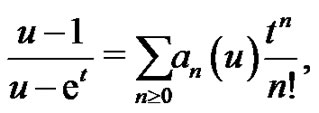 (1.9)
(1.9)
where . It is easy to see that
. It is easy to see that
 (1.10)
(1.10)
In particular,
 (1.11)
(1.11)
Hence, we call  the coefficient (polynomials) of the exponential Euler polynomial
the coefficient (polynomials) of the exponential Euler polynomial .
.
In addition, multiplying (1.9) by  and comparing the coefficients of the powers of
and comparing the coefficients of the powers of , we have the relations
, we have the relations
 (1.12)
(1.12)
Jointing (1.11) and (1.12) yields
 (1.13)
(1.13)
If  for all integer
for all integer , then (1.8) implies
, then (1.8) implies
 .
.
Thus, we have
 (1.14)
(1.14)
for all integer .
.
In the following, we call
 (1.15)
(1.15)
the Euler-Frobenius polynomial. Since
 (1.16)
(1.16)
 defined by (1.15) can be written as
defined by (1.15) can be written as
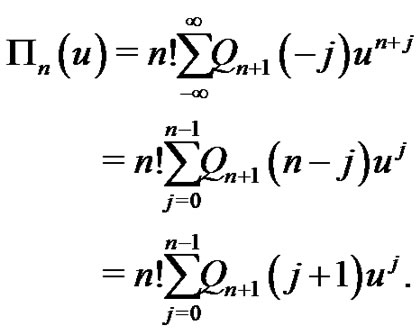 (1.17)
(1.17)
From (1.17), we know  has
has  zeros, all negative and simple, with
zeros, all negative and simple, with  a zero if and only if
a zero if and only if  is. A proof can be found, for example, in [17].
is. A proof can be found, for example, in [17].
On the other hand, from (1.9) and (1.15) we have

Transferring  to
to , we change the above equation as
, we change the above equation as

The left-hand side of the above equation can be expanded as

Comparing the right-hand sides of the last two equations yields
 (1.18)
(1.18)
(1.18) implies
 (1.19)
(1.19)
In the introduction, we give the following definition of the Eulerian polynomial of degree , which is similar to (1.18).
, which is similar to (1.18).
 (1.20)
(1.20)
where the Eulerian polynomial,  can be written in the form of (1.2) with the Eulerian numbers calculated using (1.3).
can be written in the form of (1.2) with the Eulerian numbers calculated using (1.3).
In addition, Eulerian fraction, denoted by , is defined by
, is defined by
 (1.21)
(1.21)
Comparing (1.18) and (1.20), (1.17) and (1.7), and (1.15) and (1.3), [18] gives the following results.
Proposition 1.1 [18] Let  and
and  be the polynomials defined by (1.15) and (1.9), respectively, and let Eulerian polynomials
be the polynomials defined by (1.15) and (1.9), respectively, and let Eulerian polynomials , Eulerian numbers
, Eulerian numbers , and Eulerian fractions
, and Eulerian fractions  be defined by (1.20), (1.2), and (1.21), respectively. Denote the cardinal forward B-spline of order
be defined by (1.20), (1.2), and (1.21), respectively. Denote the cardinal forward B-spline of order  by
by . Then we can set the relationship between the concepts as
. Then we can set the relationship between the concepts as
 (1.22)
(1.22)
 (1.23)
(1.23)
 (1.24)
(1.24)
As examples of the interrelationships shown in (1.22) - (1.24), we see
1) 
2) 
3)  etc.
etc.
and
1) 
2) 
3) ; etc.
; etc.
Using Proposition 1.1, [18] derives many properties of B-spline and Euler-Frobenius polynomials readily from the corresponding properties of Eulerian polynomials and Eulerian numbers, and vice versa. Applications in B-spline interpolation and evaluation of Riemann Zeta function values at odd integers are also given in [18].
Let . It is well-known that the Eulerian fraction defined by (1.21) can be written as
. It is well-known that the Eulerian fraction defined by (1.21) can be written as
 (1.25)
(1.25)
where  are the Stirling numbers of the second kind, i.e.,
are the Stirling numbers of the second kind, i.e.,  or equivalently, the number of partitions of
or equivalently, the number of partitions of  distinct elements in
distinct elements in  blocks.
blocks.
The connection shown in Proposition 1.1 also provides some important applications, shown in Section 2, of B-splines and exponential B-splines to the enumerative combinatorics. In the section, a generalized Eulerian fraction and a generalized exponential spline to the base  are derived. Section 3 discusses the applications of the generalized exponential Euler polynomials in the series transformations and expansions. Furthermore, using the combinatorial technique, we may generate exponential splines in higher dimensional setting, which will be briefly described at the end of the section and will be discussed in a later paper on the multivariate spline functions.
are derived. Section 3 discusses the applications of the generalized exponential Euler polynomials in the series transformations and expansions. Furthermore, using the combinatorial technique, we may generate exponential splines in higher dimensional setting, which will be briefly described at the end of the section and will be discussed in a later paper on the multivariate spline functions.
2. Generalized Exponential Splines
In this section, we will introduce a generalized Eulerian fraction, from which a generalized exponential spline to the base  will be derived. We shall also discuss the corresponding generalized Euler-Frobenius polynomials and their applications.
will be derived. We shall also discuss the corresponding generalized Euler-Frobenius polynomials and their applications.
It is obvious that (1.25) is equivalently
 (2.1)
(2.1)
where . Hence, we may extend the Eulerian fraction to a more general case, which will be denoted by
. Hence, we may extend the Eulerian fraction to a more general case, which will be denoted by  and called generalized Eulerian fractions associated with an infinitely differentiable function
and called generalized Eulerian fractions associated with an infinitely differentiable function :
:
 (2.2)
(2.2)
Therefore, . An analogue of the coefficients of the exponential Euler polynomials
. An analogue of the coefficients of the exponential Euler polynomials  defined by (1.10) is extended to
defined by (1.10) is extended to
 (2.3)
(2.3)
which is associated with an analytic function .
.
We now find the generating function of
 and
and .
.
Theorem 2.1 Let  be an infinitely differentiable function, and let
be an infinitely differentiable function, and let  and
and  be defined by (2.2) and (2.3), respectively. Then their exponential generating functions are
be defined by (2.2) and (2.3), respectively. Then their exponential generating functions are
 (2.4)
(2.4)
and
 (2.5)
(2.5)
where .
.
Proof. Substituting (2.2) into the right-hand side of (2.4) and using the generalized Euler series transform formula (cf. [19] and (3.1) in [20]), we can evaluate the exponential generating function of  formally as
formally as
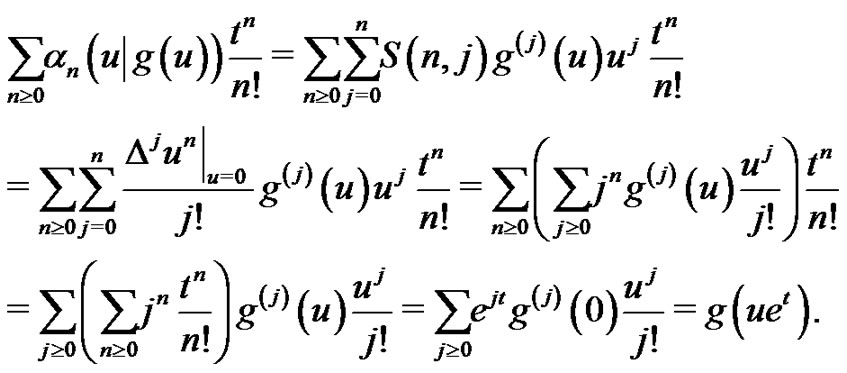
Similarly, by substituting (2.3) into the right-hand side of (2.5) and applying formula (2.4) to the resulting expression, we have
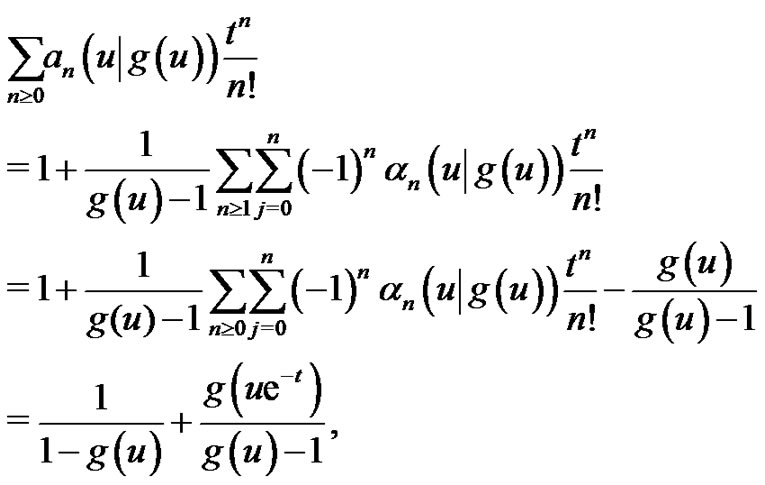
which yields (2.5) and completes the proof of the theorem.
From  we now construct polynomials
we now construct polynomials
 for
for  using the following expansion.
using the following expansion.
 (2.6)
(2.6)
Thus,  can be evaluated from
can be evaluated from  as follows.
as follows.
 (2.7)
(2.7)
for . In particular,
. In particular,  and
and

We call  the generalized exponential Euler polynomial of degree
the generalized exponential Euler polynomial of degree  associated with
associated with  to the base
to the base , and
, and  the coefficient of
the coefficient of
 . In addition, we call
. In addition, we call  the generalized Euler polynomials, and
the generalized Euler polynomials, and , the regular Euler polynomials, are the special case of
, the regular Euler polynomials, are the special case of  for
for .
.
A generalized exponential spline function to the base , denoted by
, denoted by , is therefore defined using
, is therefore defined using  (
( ) as follows.
) as follows.
 (2.8)
(2.8)
in . However, if one wants to extend
. However, if one wants to extend  to all real
to all real  associated with
associated with  such that
such that ,
,  needs to satisfy some periodic conditions. Let us consider the class of
needs to satisfy some periodic conditions. Let us consider the class of
 with real constants
with real constants  and
and .
.
Then we have the following result.
Theorem 2.2 Let function  be defined by (2.8) on
be defined by (2.8) on  associated with
associated with where
where  and
and  are real constants and
are real constants and ,
,  can be extended to a
can be extended to a  continuous function for all real
continuous function for all real  if and only if
if and only if . Furthermore, the extension is fulfilled by the functional equation
. Furthermore, the extension is fulfilled by the functional equation
 (2.9)
(2.9)
Proof. From [9], for (2.9) combined with the condition that  require
require
 to satisfy in
to satisfy in  the periodic conditions
the periodic conditions
 (2.10)
(2.10)
for . From (2.7), we have
. From (2.7), we have

Hence, condition (2.10) is equivalent to
 (2.11)
(2.11)
for all . From (2.7) (2.3), and (2.2), we have
. From (2.7) (2.3), and (2.2), we have
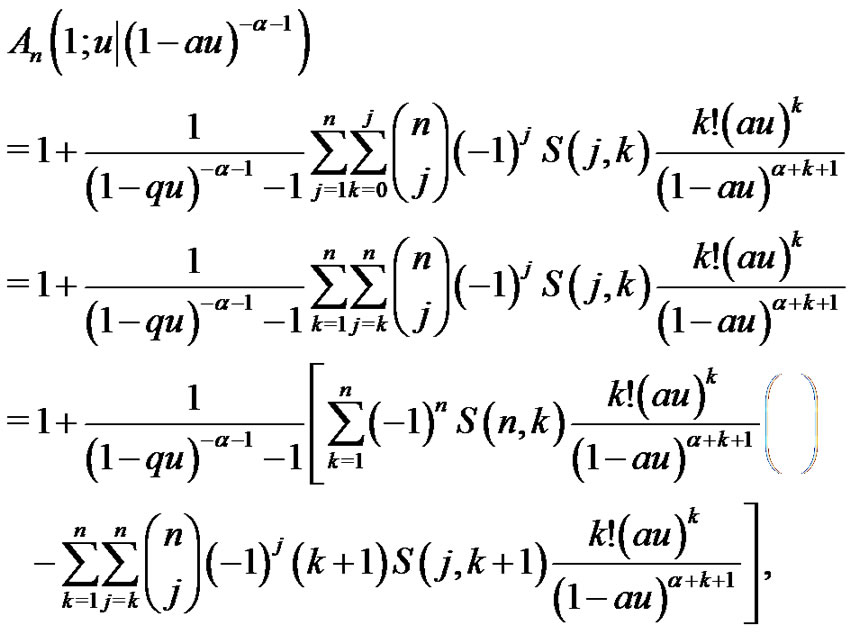 (2.12)
(2.12)
where the last step is due to the identities

and

The double sum in the rightmost expression of (2.12) can be further changed to
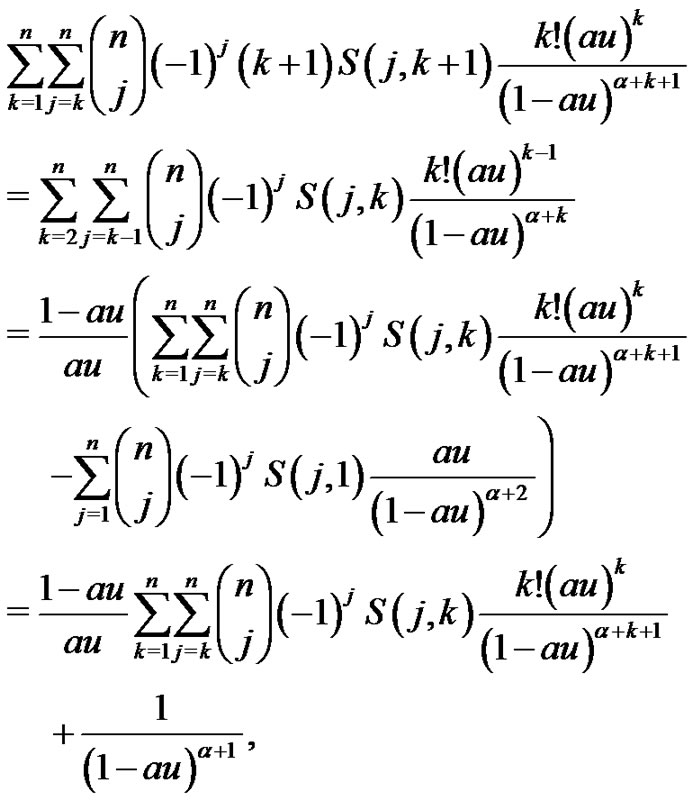
where the last step comes from  for all
for all . Substituting the last expression of the double sum
. Substituting the last expression of the double sum
 into equation
into equation
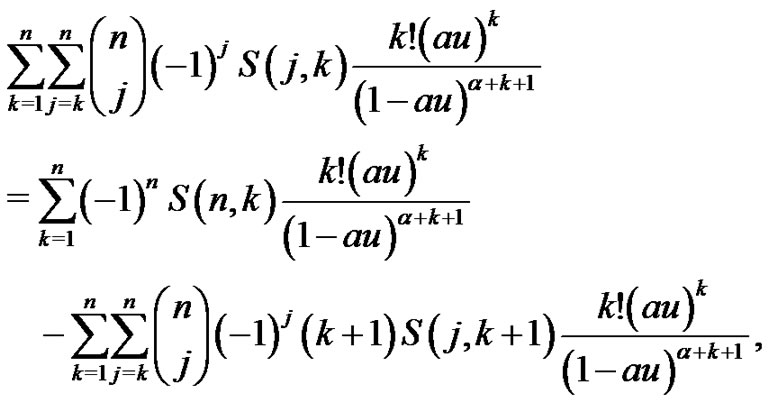
which comes from (2.12), and solving the resulting equation for , we obtain
, we obtain
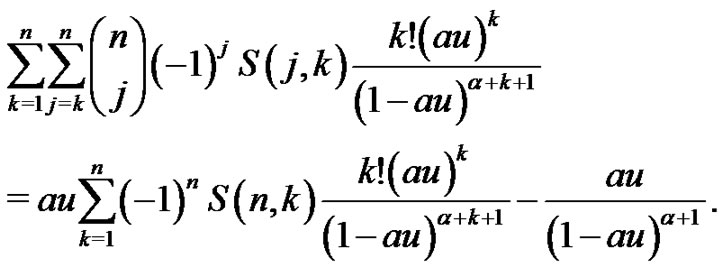 (2.13)
(2.13)
Substituting the last equation to the first equation of (2.12) yields
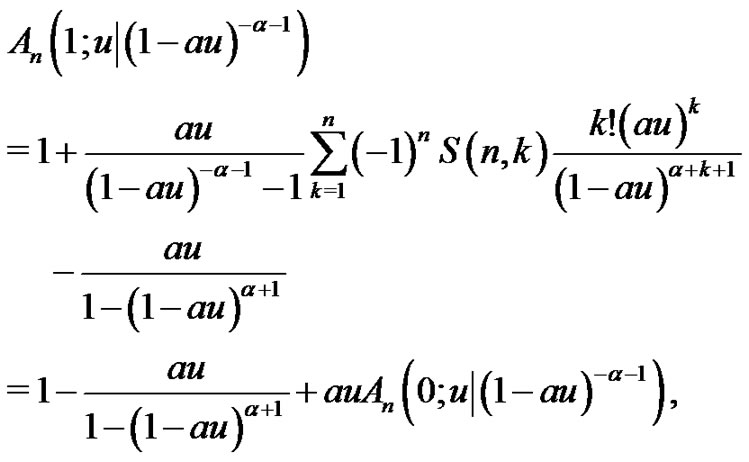
where the last step is implied by
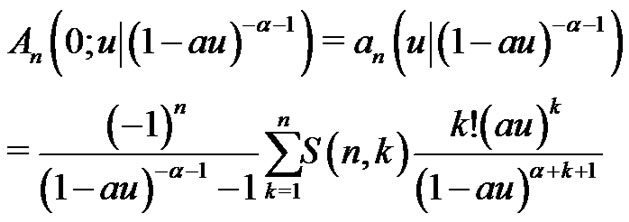
(see (2.2) and (2.3). Therefore, if
 , then
, then
 . The sufficiency is obvious. This completes the proof of the theorem.
. The sufficiency is obvious. This completes the proof of the theorem.
Remark 3.1 Other generalized exponential splines are planed to be constructed. And the properties of the exponential splines need to be investigated.
3. Applications in Series Transformations and Expansions
All formulas presented in this section are formal identities in which we always assume that  or
or  according as
according as  or
or  appears in the formulas.
appears in the formulas.
Theorem 3.1 Let  and
and  be infinitely differentiable on
be infinitely differentiable on , and let
, and let  (
( ) be the generalized exponential Euler polynomial to the base
) be the generalized exponential Euler polynomial to the base  defined by (2.6) or (2.7). Then we have formally
defined by (2.6) or (2.7). Then we have formally
 (3.1)
(3.1)
where  is not any poles of
is not any poles of  and
and  for any
for any .
.
Proof. First, we apply the operator  to the infinitely differentiable function
to the infinitely differentiable function  at
at , where
, where  is the shift operator.
is the shift operator.

On the other hand, we can present
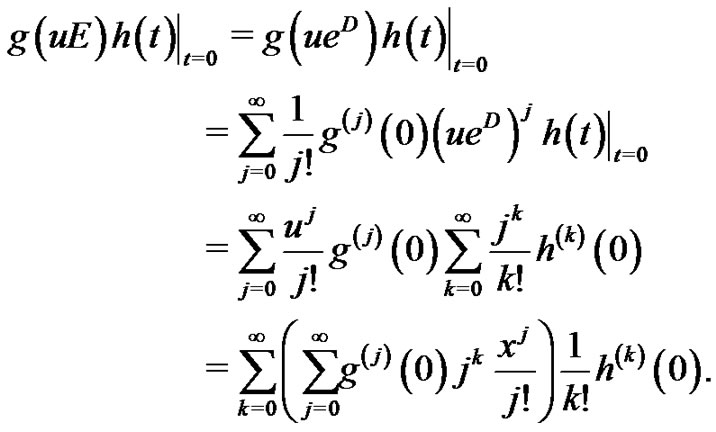
By applying (3.1) in [19] to the inner sum of the rightmost side of the above equation for  and noting
and noting , we obtain
, we obtain
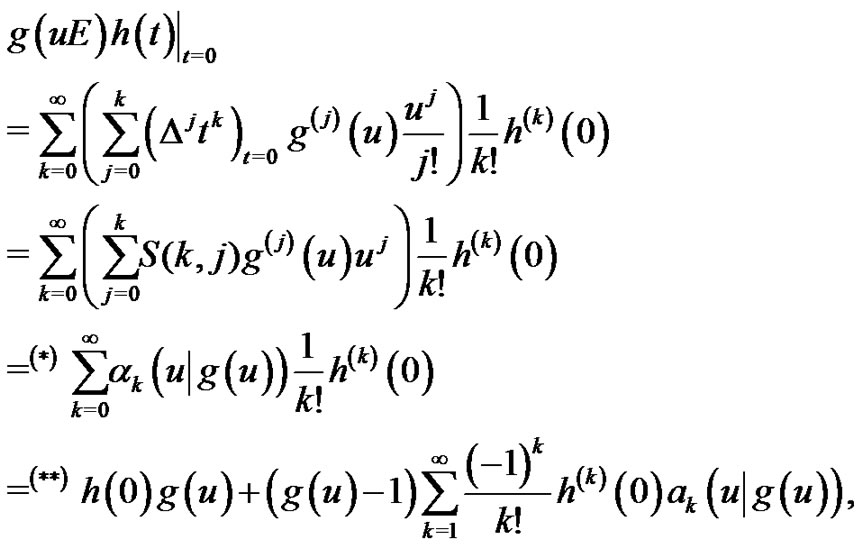
which implies (3.1) by writing
 formally, where for
formally, where for  and
and  we use (2.2) and (2.3), respectively. This completes the proof of the theorem.
we use (2.2) and (2.3), respectively. This completes the proof of the theorem.
Remark 4.1 The series transformation formulas (3.1) have numerous applications by setting different infinitely differentiable functions for . For instance, If
. For instance, If , then (3.1) becomes to
, then (3.1) becomes to
 (3.2)
(3.2)
where  and the relation (1.5) has been used.
and the relation (1.5) has been used.
Evidently, when  is a polynomial, formulas (3.1) and (3.2) become closed form of summation formulas with a finite number of terms. Moreover, the Right-hand side of each formula may also be viewed as a
is a polynomial, formulas (3.1) and (3.2) become closed form of summation formulas with a finite number of terms. Moreover, the Right-hand side of each formula may also be viewed as a  for the sequence of coefficeients contained in the power series on the left-hand side. For example, if
for the sequence of coefficeients contained in the power series on the left-hand side. For example, if , noting
, noting

we have
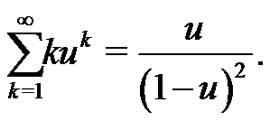
At the end of this section, we will show a way to extend our construction of exponential splines to the higher dimensional setting. First, we shall adopt the multi-index notational system. Denote





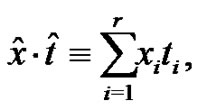
Moreover, we write  with
with  being non-negative integers. Also,
being non-negative integers. Also,  means
means 
 , and
, and  means
means  for all
for all .
.
We now define a generalized higher dimensional exponential polynomials  as follows.
as follows.
Definition 3.2 Let  be any given formal power series over the complex number field
be any given formal power series over the complex number field  with
with .
.
Then  defined by
defined by
 (3.3)
(3.3)
are called the generalized higher dimensional exponential Euler polynomials of degree  associated with
associated with  to the base
to the base , where
, where . In particular, for
. In particular, for , (3.3) defines higher dimensional exponential Euler polynomials
, (3.3) defines higher dimensional exponential Euler polynomials  of degree
of degree  to the base
to the base  by
by
 (3.4)
(3.4)
Let . Then the polynomial
. Then the polynomial  defined by (3.4) is called the higher dimensional (regular) Euler polynomial of degree
defined by (3.4) is called the higher dimensional (regular) Euler polynomial of degree . The more details will be given in a later paper.
. The more details will be given in a later paper.
4. Acknowledgments
The author greatly appreciate the discussion with Carl deBoor since 2005 and the valuable suggestions and the lecture [17] he offered fervently.
5. References
[1] L. Carlitz, D. P. Roselle and R. Scoville, “Permutations and Sequences with Repetitions by Number of Increase,” Journal of Combinatorial Theory, Vol. 1, No. 3, 1966, pp. 350-374. doi:10.1016/S0021-9800(66)80057-1
[2] L. Carlitz, “Eulerian Numbers and Polynomials of Higher Order,” Duke Mathematical Journal, Vol. 27, 1960, pp. 401-423.
[3] L. Comtet, “Advanced Combinatorics: The Art of Finite and Infinite expansions,” Springer, Dordrecht, 1974.
[4] R. L. Graham, D. E. Knuth and O. Patashnik, “Concrete Mathematics,” A Foundation for Computer Science, 2nd Edition, Addison-Wesley, 1994, pp. 267-272.
[5] D. Foata, “Distribution Eulérienne et Mahoniennes sur le Groups des Permutations,” Proceedings of the NATO Advanced Study Institute, Berlin, 1-10 September 1976, pp. 27-49.
[6] R. P. Stanley, “Eulerian Partitions of a Unit Hypercube,” Proceedings of the NATO Advanced Study Institute, Boston, 1977, p. 49.
[7] G. Birkhoff and C. de Boor, “Piecewise Polynomial Interpolation and Approximation,” Approximation of Functions, Elsevier Publishing Company, Amsterdam, 1964, pp. 164-190.
[8] C. de Boor, K. Hllig, S. Riemenschneider, “Box Splines. Applied Mathematical Sciences,” Springer-Verlag, New York, 1993.
[9] I. J. Schoenberg, “Cardinal Spline Interpolation,” CBMSNSF Regional Conference Series in Applied Mathematics, 1973.
[10] C. de Boor, “On the Cardinal Spline Interpolant to eiut,” SIAM Journal on Mathematics Analysis, Vol. 7, no. 6, 1976, pp. 930-941. doi:10.1137/0507073
[11] C. de Boor, “A Practical Guide to Splines,” Revised Edition. Applied Mathematical Sciences, Springer-Verlag, Hoboken, 2001.
[12] L. Schumaker, “Spline Functions: Basic Theory,” John Wiley & Sons, New York, 1981.
[13] O. A. Vasicek and H. G. Fong, “Term Structure Modeling Using Exponential Splines,” The Journal of Finance, Vol. 37, No. 2, pp. 339-348. doi:10.2307/2327333
[14] C. Zoppou, S. Roberts and R. J. Renka, “Exponential Spline Interpolation in Characteristic Based Scheme for Solving the Advective-Diffusion Equation,” International Journal of Numerical Methods in Fluids, Vol. 33, No. 3, 2000, pp. 429-452. doi:10.1002/1097-0363(20000615)33:3<429::AID-FLD60>3.0.CO;2-1
[15] N. Dyn and A. Ron, “Recurrence Relations for Tchebycheffian B-splines,” Journal d'Analyse Mathématique, Vol. 51, 1988, pp. 118-138. doi:10.1007/BF02791121
[16] A. Ron, “Exponential Box Splines,” Constructive Approximation, Vol. 4, no. 4, 1988, pp. 357-378. doi:10.1007/BF02075467
[17] C. de Boor, “Chapter II. Splines with Uniform Knots,” draft jul74, TeXed, 1997.
[18] T. X. He, “Eulerian Polynomials and B-splines,” ICCAM-2010, University of Leuven, Belgium, 5-9 July 2010.
[19] T. X. He, L. C. Hsu, P. J.-S. Shiue and D. C. Torney, “A Symbolic Operator Approach to Several Summation Formulas for Power Series,” Journal of Computational and Applied Mathematics, Vol. 177, 2005, pp. 17-33. doi:10.1016/j.cam.2004.08.002
[20] T. X. He, L. C. Hsu and P. J.-S. Shiue, “A Symbolic Operator Approach to Several Summation Formulas for Power Series II,” Discrete Mathematics, Vol. 308, No.16, 2008, pp. 3427-3440. doi:10.1016/j.disc.2007.07.001

